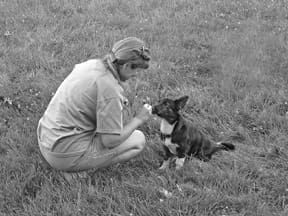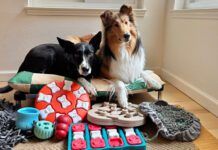By Nancy Kerns
When I hear that someone I know is getting a dog, I experience mixed feelings. I’m hopeful it will work out, and fearful that it won’t. In the six years that I’ve edited WDJ and paid close attention to such things, I’ve seen a score of my friends, neighbors, and acquaintances bring home a new dog or puppy. And, sadly, about half of those new dog/people relationships didn’t work out – a euphemism which means here, they had to find another home for the dog. When this happens, it’s not ethical, it’s not cool, it’s a tragedy for all concerned – and in my view, it all can be prevented.
Often, new-dog ventures fail most frequently when people don’t take enough time – time to research what sort of dog is really best for them, time to prepare for the dog’s arrival, and time to spend with the dog. In fact, the first thing I ask when I hear someone is thinking about getting a dog is, “How much time do you have?”

The following is a brief distillation of everything I’ve learned about what makes new dog/human relationships successfully sail off into the sunset, and what causes the ship to sink within days, weeks, or months.
Pre-planning for the dog
I never fail to be amazed at the number of people I hear about who decide to get a dog, go to the shelter, and come home with one – all in the same weekend. At least half a dozen of the sad dog/family relationship failures I’ve seen in recent years have been due to a hasty adoption; the people just didn’t take enough time to evaluate the dog or their own abilities to deal with it.
Give yourself at least a month to do some long, hard thinking about what sort of dog you want. Visualize the whole package: your ideal dog’s age, size, coat, energy level, attention span, ability to give and receive affection, sociability, portability, and health status. Plan to visit shelters a few times a week for a month or so without bringing a dog home. Keep the vision of your ideal dog in mind as you visit, even if you begin to discover that there are a few aspects of your “perfect dog” vision that you are willing to be flexible about.
But don’t depart from your vision too much! Little things can grow into big issues over time, compounding with each new problem. For example, say you have gorgeous hardwood floors in your home, and your vision of your ideal canine companion is a clean, short-haired dog. But then you fall in love with a shaggy Australian Shepherd cross. Over time, you learn that in order to keep your floors as pristine as you like them, you have to vacuum or sweep every day – or keep the dog out. And as the dog spends less time with you in the living room, he becomes more anxious and more unruly. The ship starts sinking . . . and, for the dog, the impending disaster will be titanic.
I know how hard it will be to walk away from close candidates. But I also know with a certainty that there is a perfect candidate for your “best dog ever” in a shelter near you. Don’t settle for a dog who doesn’t gladden your heart in every way, and you won’t find yourself returning an older, sadder, and less-adoptable dog to the shelter down the road.
For more in-depth information on choosing the best dog, see “How to Pick a Winner,” July 2001, on evaluating shelter dogs for a safe, friendly, adaptable temperament; “Second-Hand Friends,” April 1999, on the importance of selection and early training for shelter dogs; and “When Only a Purebred Will Do,” May 2002, on how to find your ideal breed, and how to find a responsible breeder.
Infrastructure items
As you look for your new best friend, start getting your house in order. Purchase all the stuff you are going to need: a leash, toys, chews, treats, a bed, shampoo. (See “The Dog Owner’s Hope Chest,” WDJ February 2002, for more “must-have” dog care items.) Think about containment. Do you need baby gates, a crate, tethers, a pen for the backyard, or major fencing improvements? If your home is completely prepared and able to safely and easily contain your dog, it will seem a lot easier having him live with you.
As you prepare on the physical plane, consider how your new dog’s needs are going to change your spiritual life. I’m only sort of joking; can you feel blessed and happy if you’ve been sleepless due to a whimpering puppy? Are you committed to taking walks every day, no matter how much snow has fallen, or how stifling the heat becomes? These are the kind of things you have to be ready to meet with your chin up.
And while we’re talking about full emotional preparation, how is everyone else in your household feeling about your new dog project? Does anyone in your home have reservations about the new dog’s impact on their life-styles? If so, work out solutions before the dog shows up. A tense emotional environment can definitely delay or prevent a dog’s emotional settling-in.
For more ideas on how to get the house ready, see “A Gated Community,” July 2002 and “In the Dog House,” September 1998.
A welcome home
Many people imagine that the day they bring home their dream dog will be the best day they’ll ever spend together, full of joyous discoveries and loving moments. That’s how it works in the movies!
The reality should be more like a movie shoot – scripted, structured, with all the scenery in place, and all cast members aware of their parts and on their marks.
Your new dog – the star of the show – should feel he has perfect freedom and leisure to explore his new home. In actuality, you should have constructed the set so that he is unable to go anywhere he’s not supposed to be (such as your allergic daughter’s room, or the unfenced front yard).
Also, while feeling that he is not being forced to interact with anyone just yet, he should nevertheless be under the constant supervision of an attentive family member. Don’t assume any level of housetraining, but treat him as you would a young puppy. Take him outside every hour or so, reward him richly when he relieves himself in an appropriate place, and don’t give him any opportunity to make a mistake in the meantime. When he’s in the house, keep him in your direct view, tied “umbilical cord” fashion to your waist by a leash, or in a crate until you see that he fully understands housetraining.
For descriptions of housetraining strategies, see “Getting Off to the Best Start,” January 1999 and “Minding Your Pees and Cues,” December 2001.
Finally, while your impulse will probably be to cancel everything else in your appointment book to spend every possible minute getting to know the new dog or puppy, you should follow your household’s usual routines. So many people pick up their new dog on Friday afternoon, spend the entire first weekend in a more or less constant, loving embrace with the dog, abandon him in favor of work and school on Monday –and then freak out Monday night when they come home and see all the damage caused over the last 10 frightening hours by the confused and anxious dog.
Instead, start habituating the dog to spending time alone in the house on the very first day he lives there. You accomplish this in tiny increments. Leave him alone in the kitchen with a food-stuffed Kong toy for 10 minutes while you watch TV in the next room. If he handles that okay, take him outside for an opportunity to relieve himself, and then leave him in his crate for an hour while you soak in the bathtub upstairs. Your goal is to build his confidence, in just a couple of days, that no matter how long you’re gone, you’ll return and he’ll be okay.
See “Learning to Be Alone,” July 2001, for critical information on how (and why) to prevent your dog from developing separation anxiety.
Train, train, train
My final recommendation would be to enroll in a positive dog or puppy training class as soon as possible. The more training and socialization your dog has, the better for everyone who meets him. Classes give you both an opportunity to learn to observe and communicate with each other. Practicing between classes, during walks and at home, is good mental and physical exercise for both of you. And the more time you spend together in a mutually enjoyable, interesting activity, the better it is for building permanent bonds between you.






